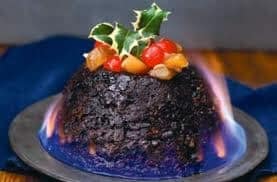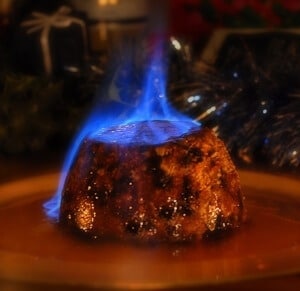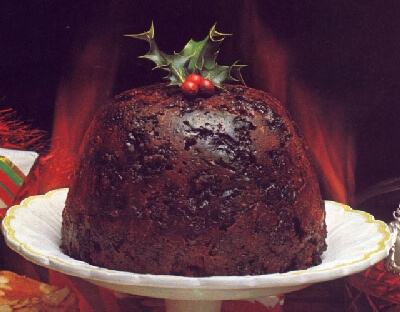Many American families still hold on to the traditional practice of serving Christmas pudding on Christmas Day along with their Christmas dinner. It is said that it originated in medieval England where it was called “mince pie” or “plum pudding.” 
In the very early days, they contained chopped poultry, pheasant, rabbit and partridge.
Then some time later, sugar, apples, raisins and candied oranges and lemons were added to the mixture.
Still later, the pudding became mainly composed of assorted dried fruits, cinnamon, nutmeg, cloves, ginger, and other spices held together by egg and beef or mutton fat and moistened by molasses or dark syrup. It is aged for at least a month.
History Christmas Pudding
According to historical accounts, the Christmas pudding was introduced in Victorian times by Prince Albert who was Queen Victoria’s husband.
It came about not as a dessert at all, but as a way to preserve meat for long periods of time. During that period in history, all surplus livestock were normally slaughtered in the autumn. The meat was then kept in a pastry case along with dried fruits to serve as a preservative agent.
The resulting “mince pies” could then be used to feed large numbers of people during the winter months and especially at the festive Christmas season.
In 1595 the recipe changed as spirits, dried fruit, eggs and breadcrumbs were added. This became known as plum pudding.
In 1714, King George I asked that plum pudding be served as part of his royal feast in his first Christmas in England after arriving from Hanover. However, around this time, meat was no longer part of the ingredients. Its taste and appearance then was already broadly similar to that of our Christmas pudding today.
The traditional Christmas pudding was made on a Sunday four to five weeks before Christmas. Called “Stir-up Sunday,” every member of the household customarily gave the mixture a stir while making a wish.
Traditional Christmas pudding
It was also customary to include small tokens in the mixture like silver coins, a ring, a thimble and a miniature anchor for luck, wealth and good health in the coming year. Before serving, it is decorated with holly, doused in brandy, ignited and set on flames.
It is brought to the table ceremoniously to a round of applause. It is often eaten with rum or brandy butter, lemon cream, custard and sprinkled with sugar.
The traditional Christmas pudding usually weighed about a pound at the start and got heavier as Christmas time approach since families tended to add more dried fruits, more spices, more eggs and more brandy whenever they could afford to do so.
Christmas puddings have very good keeping properties. It can age for a long time and because it has so much alcohol in it, it really never spoils.
In fact, in the old days, many families keep some Christmas leftovers to be eaten at Easter or at another later celebration during in the year. Nowadays, since most people can just serve store-bought Christmas puddings, there’s no need to be too thrifty with the servings.



Leave A Comment